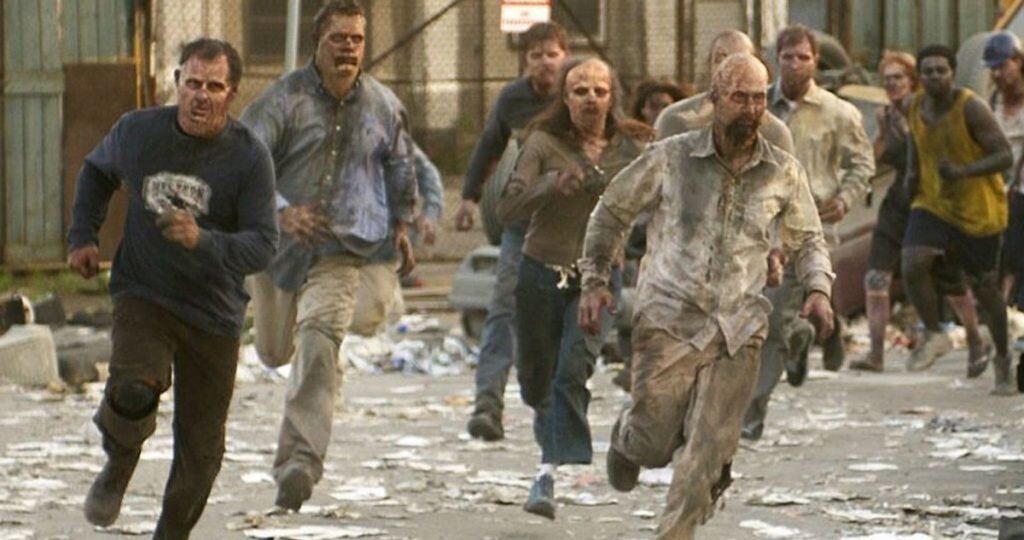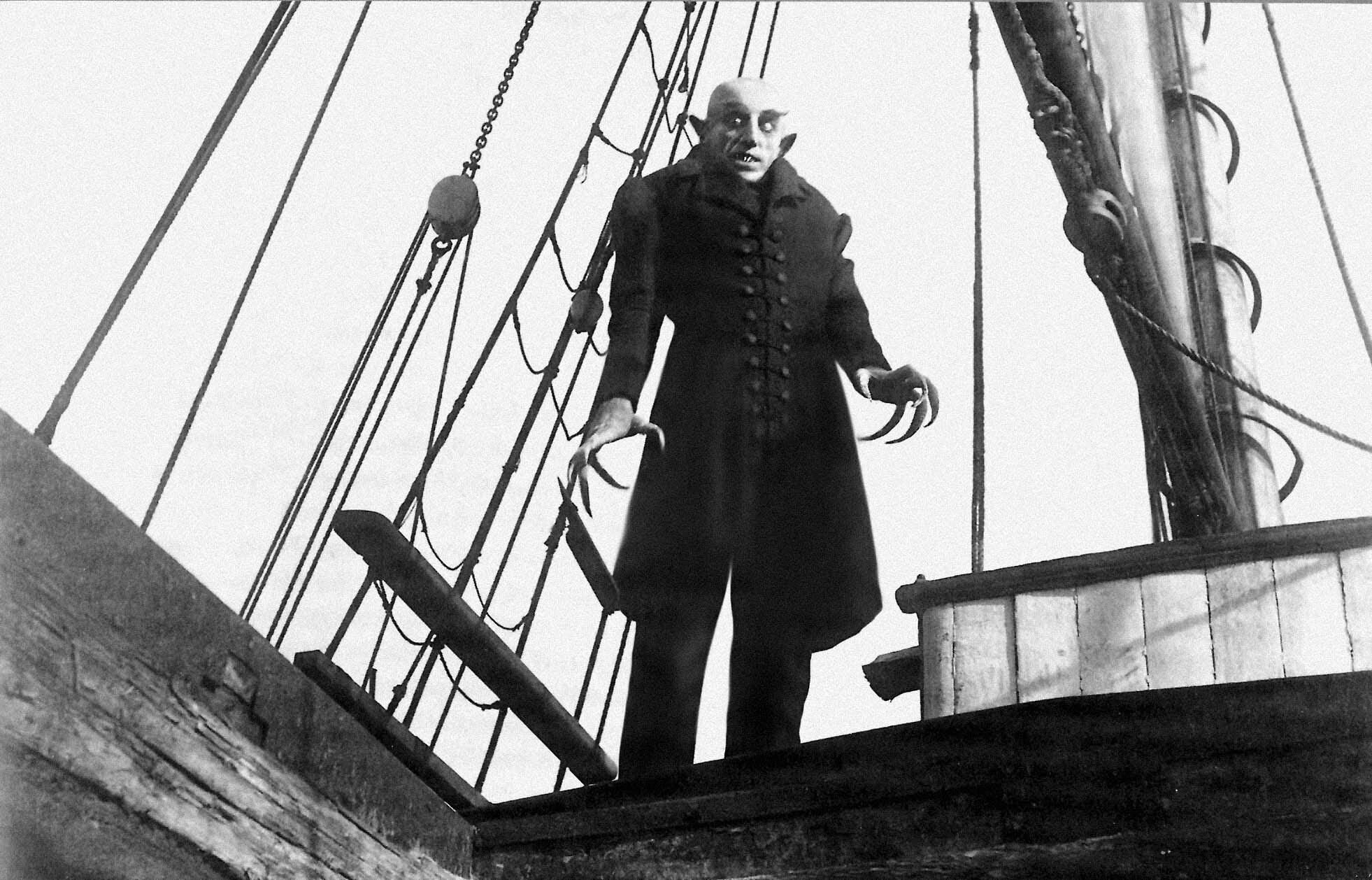That Is Not a Zombie
A SPOILER-Free Zombie Rant
Usually we have a thing here about how we’ll spoil any damn movie we want, but that’s not the case with this article. We’re still talking zombies this week, and Meg mentions lots of zombie and zombie-adjacent movies and TV in here, but we’re pretty sure there are no real spoilers. It’s a ranty article, though, so buckle up, kids!
Fast zombies doing fast zombie things in Army of the Dead (2021)
A while back, in search of early zombie movies in the spirit of Night of the Living Dead (1968), we watched The Last Man on Earth (1964), which got us interested in its remakes, The Omega Man (1971--a terrible movie) and I Am Legend (2007--an unfortunate fumble). And that prompted a lively debate on what makes a zombie a zombie, after which Eric finally got me to watch 28 Days Later (2002).
Technically, Last Man, its remakes, and the Richard Matheson novel on which they’re based, also called I Am Legend (1954), all call the monsters “vampires.” But each of the films muddles together various myths and legends to create a unique and perplexing mash-up of three separate supernatural beings: the vampire, the zombie, and the ghoul.
The “vampires” that Dr. Robert Morgan (Vincent Price) faces in Last Man feel more like modern-day zombies, with slow, catatonic movements and a mostly-mindless existence--except when they’re yelling, “Morgan, come out! Come out, Morgan!” But they also only come out at night, are repelled by garlic, and hate mirrors. You know, “classic” vampire stuff that’s more modern than you might think.
By the end of Last Man, the group of infected-but-not-totally-vampire people rebuilding society in their image are no longer human. But they’re also not vampires. Or zombies, even though they were, at one point, sort of vampiric and sort of zombie-ish.
The creatures in The Omega Man have lost all pigment in their skin, eyes, and hair. They dress in brown tunics and wear sunglasses at night. They also build and operate trebuchets and talk in complete sentences, with some ridiculous philosophical babble about why we should return to the Old Ways blah blah blah. Their fatal sensitivity to light and the sun have somehow caused them to condemn science and technology and turn into some weird cross between medieval, undead cultists and a vampiric biker gang. Think Lost Boys meets Monty Python’s version of The Spanish Inquisition, but played with no irony.
Then you have I Am Legend’s monsters, which are sensitive to sunlight and drink blood, but they look more like demonic ghouls, and they act like enraged beasts who experience only base human emotions. Except they also feel love and tenderness. It’s a lesson in something, I guess.
A not-undead “zombie” that appears to be slowly dying in 28 Days Later
Also worth noting, the monsters in 28 Days Later are humans who’ve been infected, as one scientist helpfully explains, with “rage.” They're still alive, don’t eat flesh, and can be killed by normal non-head-shooting means. At best, these are zombie-adjacent living people with laboratory-leaked super rabies. (Nice try, fast zombie advocates!)
So let’s talk zombies and ghouls and vampires--all different, specific creatures with different desires that serve different purposes when it comes to popular media and cultural commentary. Because the creatures in Last Man and its remakes are all crap, and so are fast zombies, and any zombie that can really talk. Zombies are an undead funhouse mirror, a decrepit parody of humanity meant to reflect our worst traits back at us. Therefore, living breathing humans, full of greed, anger, fear, and bigotry, should always be more dangerous than stupid, slow-moving zombies.
Think of this as an article in defense and celebration of the Romero zombie and its power as a symbol and critique of humanity. It’s also just fun hating on fast zombies.
The Modern Zombie
From Night of the Living Dead, the first Romero zombie to appear on the big screen.
Kevin Boon, a professor of English at Penn State University, Mont Alto, published an essay called “The Zombie as Other: Mortality and the Monstrous in the Post-Nuclear Age” as part of a collection of essays by various authors called Better Off Dead. He says the first known zombie references come from African tribal mythology--though Haitian folklore is often cited as the original source material for the zombie myth.
When zombies first appeared on screen, filmmakers took their notes from Haiti. In “Take, Eat, These Are My Brains,” part of another zombie essay collection, Zombies and Sexuality: Essays on Desire and the Living Dead, the horror author and zombie expert Steve Jones writes that older films like White Zombie (1932) and I Walked with a Zombie (1941) show zombies, whether dead or alive, as “mindless slaves … with no autonomy or will.”
That was pretty much the norm for the next three-plus decades, until George A. Romero and John A. Russo’s Night of the Living Dead (1968--also, it turns out, loosely inspired by the novel I Am Legend) gave us the undead flesh-eaters we all know and love today. We’ve returned to the Romero zombie ever since for social and cultural commentary on consumerism and the loss of self.
At first, Romero and Russo thought of the monsters in Night of the Living Dead as ghouls, but the media and the public kept saying “zombie,” and it stuck, giving rise to the Romero zombie: mindless walking dead driven by primal, cannibalistic hunger who can’t be killed unless you kill the brain. We relate, in a bizarre way, to this zombie. It represents palpable human fears: loss of self, loss of free will, capitalist excess and greed, and mindless consumerism; and more tangibly, the death of a loved one, desecration of the dead, and all kinds of body horror. The body horror, by the way, is the worst part of zombie movies for me.
For the sake of simplicity, here’s a set of guidelines for the “Romero” zombie--baseline definitional stuff that carries over to popular media beyond Romero: undead, flesh-eating creatures that lack self-awareness and intelligent thought, that are incapable of socializing (except on base levels with one another), have little or no control over their actions, and either can’t communicate at all or only with great difficulty, rarely with language, and never with more than a few words.
Essentially, in the US at least, the common, modern-day Romero zombie is most often used to comment on consumerism and conformity and to lay bare a very American fear about the erosion of the self in a sea of marketing, television, and gluttony. In general, zombies might be drawn to the things they were once drawn to in life, as is exquisitely parodied in The Dead Don’t Die (2019), but they seldom have a will or mind of their own. In most cases, their only real desire—the only thing they truly need—is human flesh. (Once in a while, it’s specifically brains, as in the remarkably silly Return of the Living Dead (1985), an early example of the now-common zombie parody.)
Big Daddy in 2005’s Land of the Dead.
There are, of course, occasional subversions of and aversions to these zombie-trope staples. Toward the end of the Night of the Living Dead’s sequel, Dawn of the Dead (1978), some of the zombies start re-learning how to handle weapons. In the next sequel, Day of the Dead (1985), lead scientist Dr. Matthew “Frankenstein” Logan tries to rehabilitate or domesticate the hostile creatures. Enter zombie “Bub,” an apparently docile creature who seems to remember being human and can do some basic human things like shaving, saluting his superiors (apparently a military man in life), and also shooting people with guns. And in Land of the Dead (2005), zombie “Big Daddy,” a former gas attendant, leads his fellow, somewhat intelligent, undead friends in their assault on the city of human survivors.
All of these examples offer parodies of humanity. And while these zombies “evolve” beyond the mold that Romero himself helped establish, they still work the same basic way: as funhouse mirrors of humanity offering slow and impending doom, along with cannibalistic body horror and loss of self. Most importantly, though, they’re nowhere near as dangerous as living humans.
A Flesh-Eater Is Not (Necessarily) a Zombie
Watching Drew Barrymore eat people in Netflix’ The Santa Clarita Diet (2017-2019) is really great, disgusting fun.
So what does this all mean for the undead, cannibalistic creatures in shows like The Santa Clarita Diet (2017-2019) and iZombie (2015-2019), whose “zombies” retain their conscious selves, work themselves over with makeup to pass as human and hide their decay, but still need to eat people to get by?
I don’t know the answer to that, but they’re definitely not the modern Romero-style zombies I’m talking about here. You might be able to make an argument for “revenants,” animated corpses that return from death to haunt the living, but usually revenants come back for a specific purpose, and none of the undead in those examples has a clear purpose (as far as I know, but I never finished iZombie, so feel free to correct me on that).
Eric asked whether the above examples could be ghouls, but the ghoul, zombie-adjacent or not, is in its own category of supernatural fiend. Much less prevalent in popular media than its zombie cousin, the ghoul lurks in cemeteries and uninhabited spaces and, yes, like the zombie, feeds on human flesh. But the consumption of human flesh does not a zombie make. And ghouls will just as readily feast on the dead as they will the living, but zombie landscapes are littered with half-eaten bodies, not skeletons picked clean of their viscera.
Considered a kind of jinn from pre-Islamic Arabian folklore, ghouls can shape-shift to appear human or animal and didn’t really enter into Western culture’s scope of myths until The Thousand and One Arabian Nights was translated into English. The lore I’ve found, not nearly as pervasive as vampire or zombie mythology, often describes the ghoul as an evil spirit or demonic supernatural being that likes to eat lone travelers, sometimes luring them to their deaths like the Greek siren or the cross-cultural Lady in White.
While zombies and vampires were once human, most ghouls were never human. That’s not always the case though, and the ghouls that were once human are very similar to the wendigos of Native American legend. People who, on the brink of starvation, eat human flesh, such legends say, bring a curse of undead cannibalism upon themselves. In modern media, ghouls and wendigos are often used to comment on the consequences of gluttony, taboo, and greed.
A Vampire Is Not a Zombie (& Neither Is a Cultist)
Anthony Zerbe as Jonathan Matthias in the ridiculously bad Omega Man.
It’s interesting that Night of the Living Dead was loosely inspired by Richard Matheson’s novel I Am Legend. Interesting because the novel features vampires, not zombies, a point that all of the film adaptations seem to have missed. 1964’s The Last Man on Earth features “vampires” who wander around like zombies but have all the vampire trappings. 1971’s The Omega Man turns them into those weird cult dudes. And 2007’s I Am Legend jacks them up into jaw-unhinging demon whatevers.
But the vampire is a specific kind of creature whose particular brand of horror doesn’t work the way these movies try to make it work.
The breadth and width of vampire lore is so unbelievably vast that digging into it would likely turn this into a whole series of articles, so I’ll save that for another time. But, whether you think of Anne Rice or The Lost Boys or Buffy the Vampire Slayer when you think of vampires (which is to intentionally ignore vampires that glitter), the common characteristics popular culture has settled on for these monsters remain mostly the same: fangs, aversion to sunlight, and a need for blood. And, of course, a stake through the heart can usually kill them.
Max Schreck as Count Orlok in 1922’s Nosferatu.
The Nosferatu vampire is a different matter entirely, and Bram Stoker’s original Dracula from the novel Dracula (1897) isn’t actually anything like any of these iterations, but again, too much. See what I mean about a whole series? Not today. Moving on.
While not a hard-and-fast rule, modern-day vampires often indulge instinct and desire--sometimes in a bougie and homoerotic Anne Rice-y way, sometimes in an ‘80s teen bad-boy way, sometimes in a Buffy demonic evil-for-evil’s-sake way, and sometimes in a drug-addicted way like Aidan Turner’s Mitchell in the 2008-2013 British series Being Human. Their bloodlust is a metaphor for voracious and destructive appetites and dark, dangerous pleasures.
They’re also often used to comment on sex as a primal, animalistic drive. Even the earlier, less romantic and more grotesque Nosferatu vampires have a kind of magic or charm that can seduce a victim or put them into a trance.
The conflated zombie-vampires, bizarre cultist plague victims, and mutant super-ghouls in each of the I Am Legend film adaptations is a weird thing that drags all three movies down for different reasons. They come across as silly mashups of different creatures that serve different purposes in terms of what they do in a story and in terms of what they represent to audiences and critics.
And Richard Matheson’s I Am Legend novel and its film adaptations aren’t about greed or gluttony or sexuality or the id. The most compelling themes of the films—the need for companionship, blind self-aggrandizement, the horrors of isolation—just don’t match the weird hybrid monsters. They work better in the novel, but mainly because the novel is all about how Robert Neville (Robert Morgan in the first film) is a monstrous person. In other words, it works because humanity is more frightening than the zombies (or vampires).
The Romero Zombie Matters
Sherman Howard as the beloved zombie “Bub” in 1985’s Day of the Dead.
The Romero zombie--the flesh-eating, slow-moving, kill-the-head undead modern zombie--matters today not because it’s a terrifying and powerful threat. It’s weak and slow and dumb. It shouldn’t be threatening.
The most threatening part of any good zombie story is not the zombies; it’s other humans. The Romero zombie still matters because it reminds us that we are our own greatest threat to ourselves.
In The Dead Don’t Die, the zombies are a (rather silly) allegory for climate change and our failure to respond to it. In the original Living Dead films, they’re reflections of racism, consumerism, and capitalist excess.
The fast zombie has a way of stripping all that away. It’s the zombie that’s the threat, not human racism or greed or hyper-masculinity. The fast zombie doesn’t have the time to stumble around shopping malls or perform bizarre mockeries of the things they did in life. They’re too immediate and rapid a threat to stand in for climate change or any other kind of inevitable but slow-moving doom.
Instead, the fast zombie is all about action, getting characters to run away and narrowly escape and blow things up. That is to say, fast zombies turn perfectly good, terrifying horror into indulgent action slogs--you know, Zack Snyder movies.













